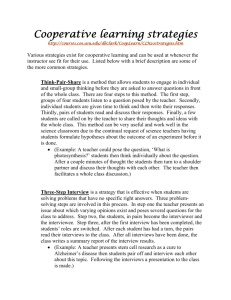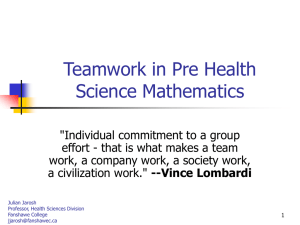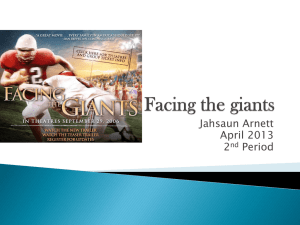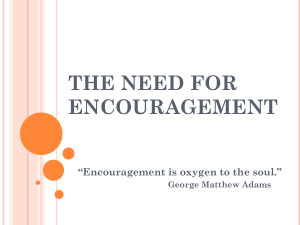Why Cooperative Work Groups
advertisement
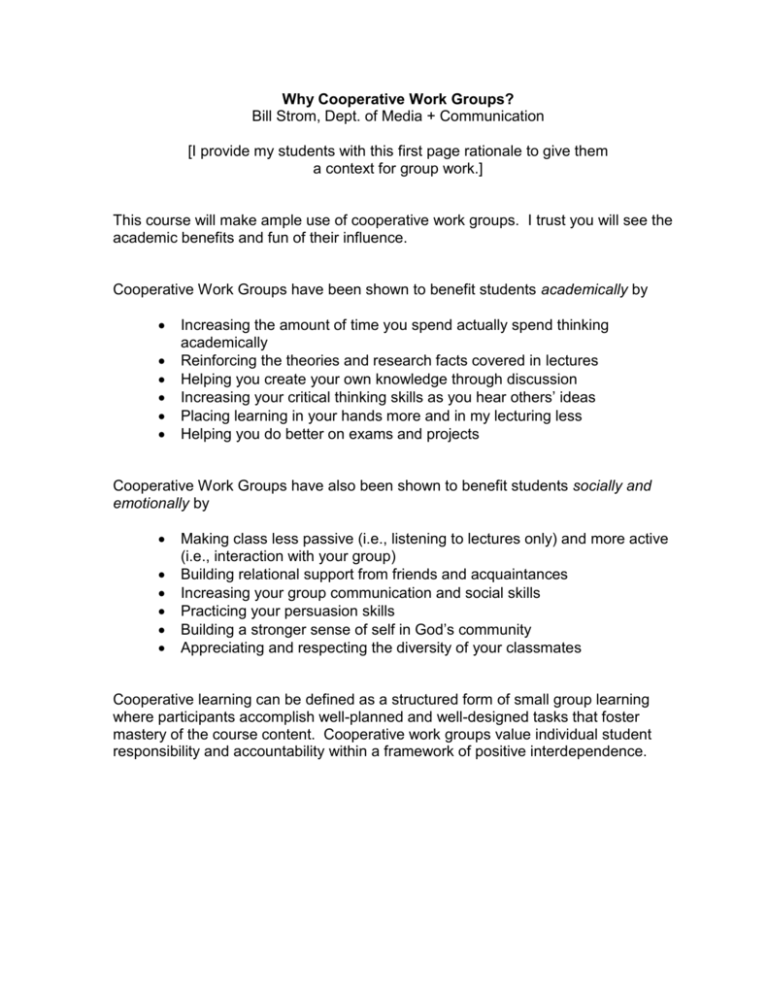
Why Cooperative Work Groups? Bill Strom, Dept. of Media + Communication [I provide my students with this first page rationale to give them a context for group work.] This course will make ample use of cooperative work groups. I trust you will see the academic benefits and fun of their influence. Cooperative Work Groups have been shown to benefit students academically by Increasing the amount of time you spend actually spend thinking academically Reinforcing the theories and research facts covered in lectures Helping you create your own knowledge through discussion Increasing your critical thinking skills as you hear others’ ideas Placing learning in your hands more and in my lecturing less Helping you do better on exams and projects Cooperative Work Groups have also been shown to benefit students socially and emotionally by Making class less passive (i.e., listening to lectures only) and more active (i.e., interaction with your group) Building relational support from friends and acquaintances Increasing your group communication and social skills Practicing your persuasion skills Building a stronger sense of self in God’s community Appreciating and respecting the diversity of your classmates Cooperative learning can be defined as a structured form of small group learning where participants accomplish well-planned and well-designed tasks that foster mastery of the course content. Cooperative work groups value individual student responsibility and accountability within a framework of positive interdependence. Everyone Plays a Role in Your Group Each group will consist of 3-4 members, and each member will have a chance to play each role described below. After you have played your role for two consecutive activities, your team members will rotate to take on new roles for the next two activities. (Eight activities take place throughout the semester.) Leaders 1. Get the group focused on the task (whatever it is that day) 2. Move the group along in the task 3. Manage the flow of conversation so everyone gets involved 4. Delegates out-of-class assignments to various members Recorders 1. Get the team’s folder from the instructor each day 2. Keep attendance 3. Summarize the group’s discussions in paragraph form 4. Hand in the folder at the end of the day Encouragers 1. Encourage people to contribute their ideas 2. Serve as the group’s biggest fan—affirm people for their ideas 3. Try to be a harmonizer when members conflict 4. Encourage members to accomplish out-of-class work Speakers 1. Serve as the spokesperson for their group 2. Give brief impromptu oral reports for things discussed in your group 3. Write group answers to questions on the board when asked Assigned Roles: You will play each role twice. Here’s how you know when it’s your turn to play what role: List your group members by first name in alphabetical order. Where you fall in the list determines your role (see reverse side for table). 1. 2. 3. 4. Bob Hall Erica Porter Jerald Manns Willma Johnson becomes “A” becomes “B” becomes “C” becomes “D” See the schedule of when you play your role on the reverse of this sheet 2 Cooperative Task Activity Number 1 2 3 4 5 A Leader Recorder Speaker Encourager Leader B C Recorder Speaker Encourager Leader Recorder Speaker Encourager Leader Recorder Speaker D Encourager Leader Recorder Speaker Encourager So, when we do Task Activity #1, Person A is leader, B is Recorder, C is Speaker, and D is Encourager. If you have 5 people in your group, the person “E” follows the same order as person “D” and they negotiate who records, otherwise they can co-lead, co-speak, coencourage. If you have 3 people in your group, no one is the formal encourager—you all get to encourage the other! See the syllabus for cooperative task activity numbers on the day-to-day schedule. 3 Collaborative Task #1: What to do with the Students from Mongolia? Group Name: ________________________ Who’s here: ________________________ ________________________ ________________________ ________________________ Who’s gone: _________________________ Note: See sheet for who does what.. This task requires you to do a little pretending. Pretend that all of you are members of a student life steering committee at TWU. The committee has been formed to determine principles and policies for students new to TWU. Recently student life learned that seven students from northern Mongolia would be entering TWU. Northern Mongolians are semi-nomadic herdsmen and farmers who carry most of their belongings on simple carts pulled by horses. Many have never seen telephone lines much less telecommunication dishes. They are family-oriented, hardworking, and bright, but have never had formal education. Your task is to consider any special procedures, principles, or policies TWU might engage to help these students adapt to the hustle and bustle of TWU life. One idea is to place these students in a “no media” dorm where the rooms and lounges are free from computers, televisions, stereos, and internet access. This is called the “media free” idea. A competing option is called “media enmeshment” and would see the students in regular dorms with easy access to all media as other TWU students enjoy. Which of these two approaches do you recommend for the students? Or might you recommend a mix? How might time and timing fit in? Write an answer that articulates your position, and as you do, argue your case by referring to McLuhan’s media ecology Gerbner’s cultivation theory Hall’s cultural / Marxist approach Please make specific applications by referring to ideas and research from each theory. Your answer should address the benefits and challenges for the Mongolian students in a media-free or media-enmeshed setting. 4 Please write your response in the form of a letter to Mr. Sheldon Loeppky, vice provost of student life. Collaborative Task #2 Can Relational Theories Shed Light on Complex Relationships? Please change roles: see blue sheet in folder (“A” become recorder, “B” becomes Encourager, etc.. If you have 5 members, “E” is an encourager.) Also note who’s here and who’s not: Here: ___________________________ ___________________________ ___________________________ ___________________________ ___________________________ Not: __________________ This task is based on the lyrics of “How to Save a Life” by Slade and King of The Fray. Please read them now. Part I. Altman and Taylor’s Social Penetration Theory asserts that the breadth (number) and depth (intimacy level) of our disclosures builds and reflects the nature of our relationships. Suppose the two characters represented in this song were real people who had an interaction similar to the one in the lyrics. Analyze how Altman and Taylor would understand these disclosures, or lack thereof. Use any ideas from their model that seem to apply to explain how she and he have arrived at this crossroad in their friendship. (use your own paper) Part II. Please analyze the lyrics through the lens of Baxter and Montgomery’s Relational Dialects by answering the following questions: a. Are the song’s lyrics best explained by the their list of “internal dialectics” or “external dialectics”? Why? (about 3 sentences) b. Which dialectics, including Rawls’ acceptance-judgment dialectic, appear to be at work in the lyrics / relationship? Explain your answers in language like this: “The inclusion-seclusion dialectic appears to be expressed in the lyrics “xxxx xxx xxxxx xxxxx” because ….” Make sure you show a good working knowledge of the dialectics as you apply them. (about 5-6 sentences) (Part III, PTO) 5 Part III. In Watzlawick, Beavin, and Jackson’s Interactional View, relationships are understood within systems of communicative rules. The authors suggest that within these systems (or “ceiling mobiles” as Griffin says), five axioms are at work. Apply as many axioms in a relevant way to understand the relationship in “How to Save a Life.” Don’t stretch them too much, but make genuine application of their insights into the relationships evident between the guy and girl in the song. 6
